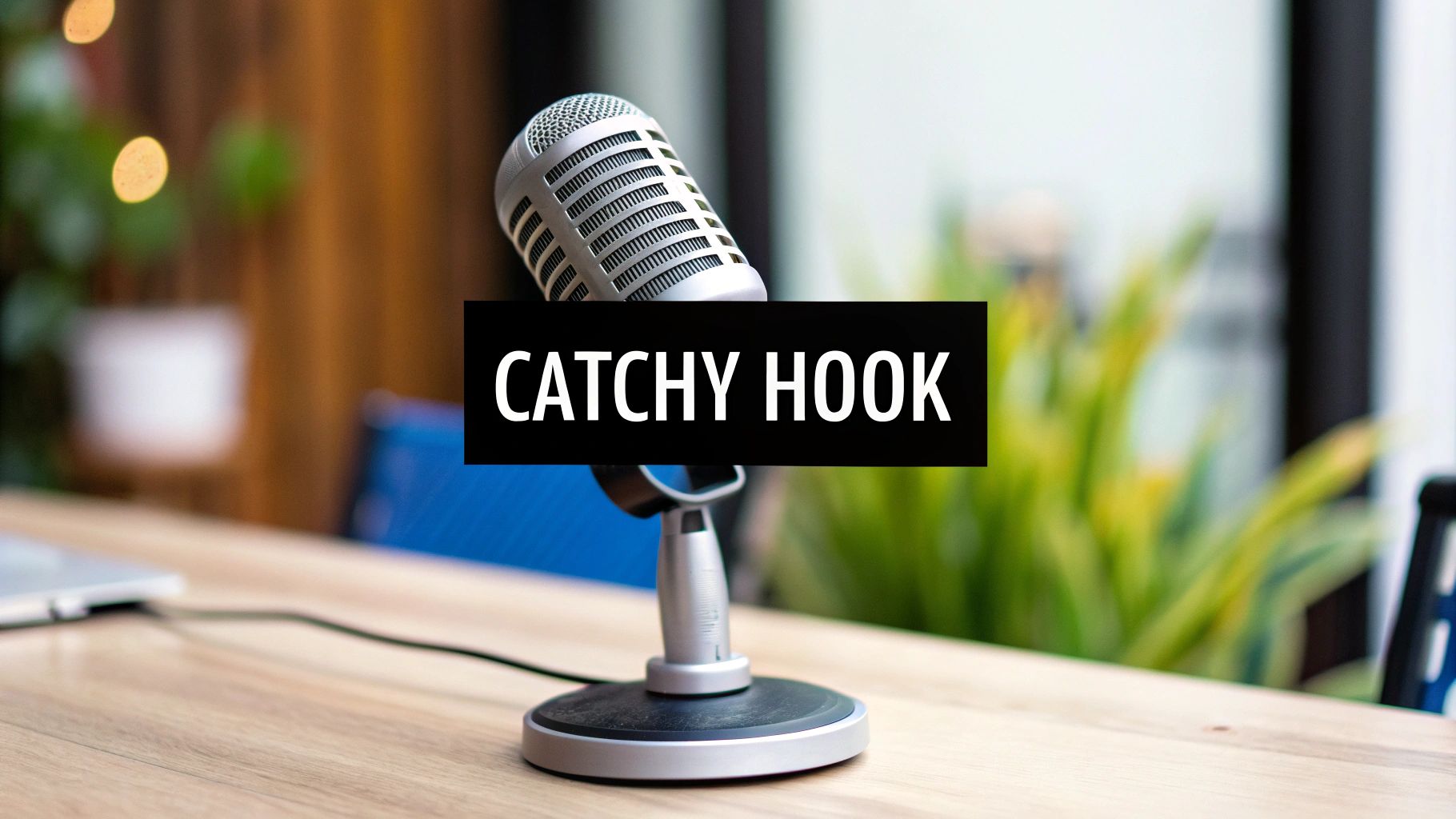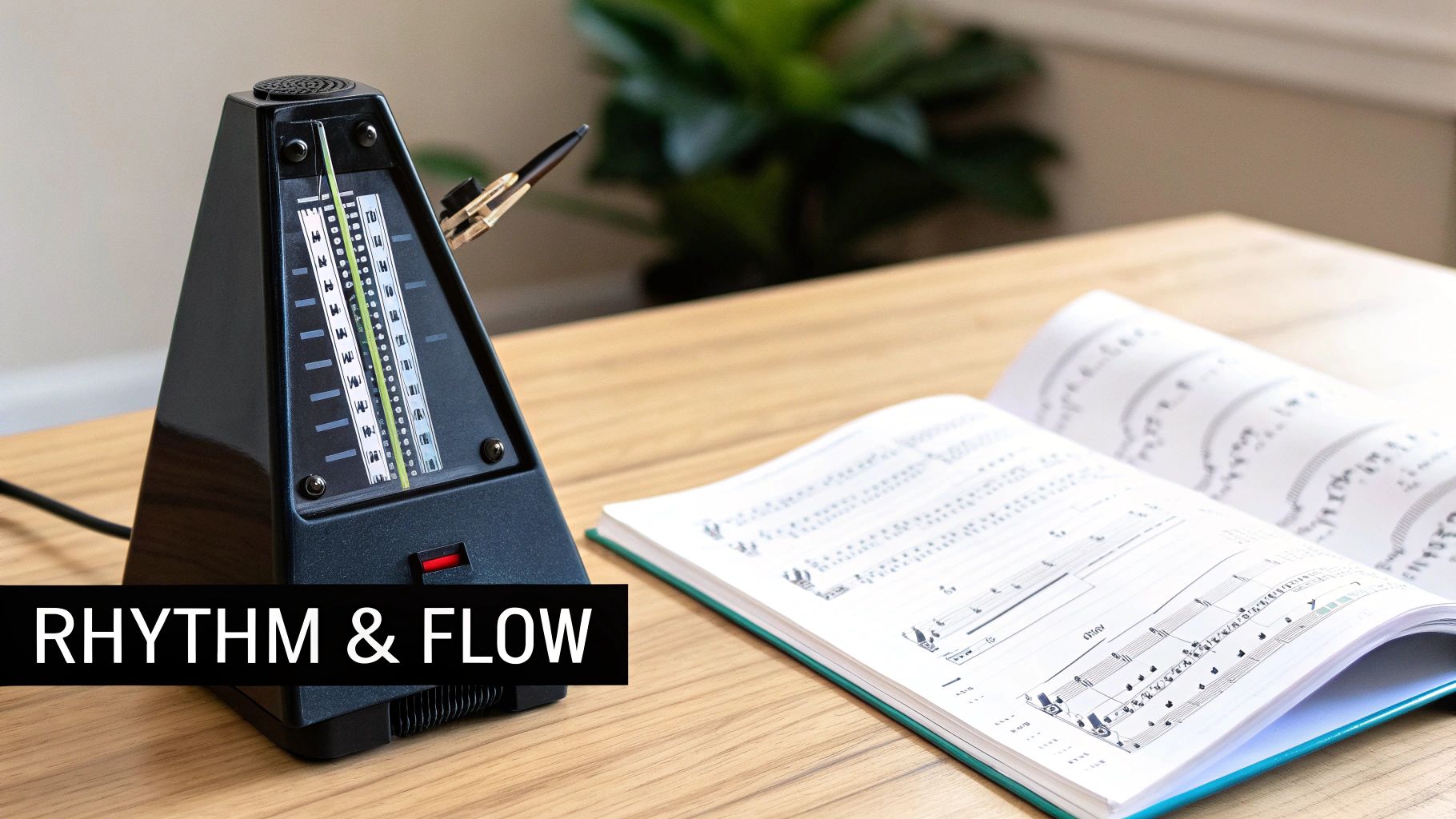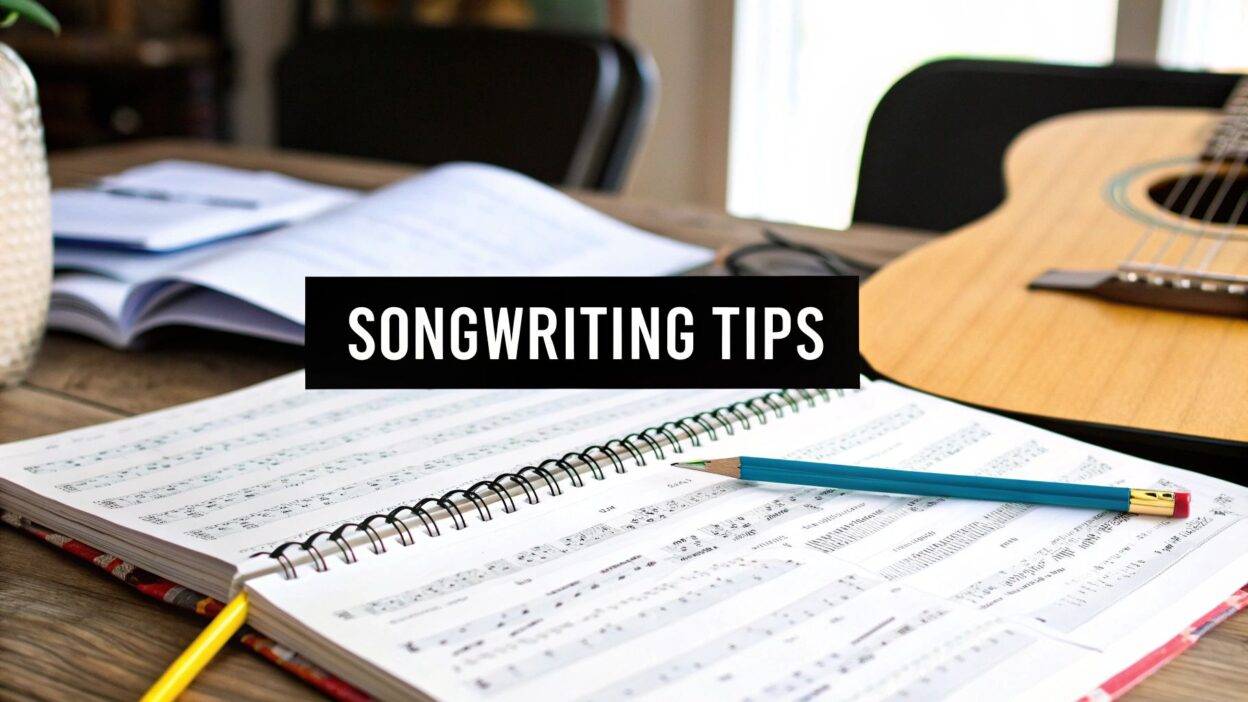Getting Started
Crafting compelling lyrics is the heart and soul of songwriting. It's the art of weaving words and emotions into a tapestry that resonates with listeners. This listicle delivers actionable tips for writing song lyrics that capture attention and leave a lasting impact. Whether you're a beginner songwriter searching for foundational guidance or a seasoned musician aiming to refine your lyrical prowess, these insights will equip you with practical techniques to elevate your craft. We'll delve into specific methods for constructing memorable verses, crafting impactful hooks, and ensuring your lyrics work seamlessly with your music.
Why are these concepts crucial? Because impactful lyrics distinguish a good song from a truly great one. They transform simple melodies into emotionally charged experiences, forging connections with listeners on a deeper level. A well-crafted lyric can evoke a visceral response, trigger memories, and offer solace or inspiration. This listicle will provide the tools you need to achieve that level of lyrical resonance.
Here’s a preview of the essential tips we'll cover, providing you with a comprehensive toolkit for writing impactful song lyrics:
-
Write From Personal Experience and Emotion: Tapping into genuine emotions and experiences adds depth and authenticity to your songwriting.
-
Master Song Structure and Format: Understanding the framework of a song provides a strong foundation for crafting impactful lyrics.
-
Show, Don't Tell: Employ vivid imagery and metaphors to paint pictures with your words, enabling listeners to connect with your message on a sensory level.
-
Develop Strong, Memorable Hooks: Craft hooks that are instantly catchy and memorable, drawing the listener in and leaving a lasting impression.
-
Pay Attention to Rhythm and Flow: The rhythm and flow of your lyrics should complement the melody, creating a seamless blend of words and music.
-
Use Strategic Rhyme Schemes: Experimenting with various rhyme schemes adds depth and musicality to your lyrics.
-
Edit and Refine Ruthlessly: Polishing your lyrics through careful editing and revision is key to ensuring clarity and precision.
-
Understand Your Target Audience and Genre: Tailoring your lyrics to your target audience and genre helps connect with listeners and establish your unique style.
This listicle cuts through the noise and delivers clear, actionable strategies. By the end, you'll possess a richer understanding of how to write compelling lyrics that resonate with your audience. Let's begin!
1. Write From Personal Experience and Emotion
One of the most potent tips for writing song lyrics is to draw from the wellspring of your own experiences. This means tapping into the raw emotions, significant moments, and unique observations that shape your personal narrative. Instead of constructing lyrics around abstract concepts, ground them in the tangible reality of your life. This authenticity resonates deeply with listeners, forging a powerful connection through shared human experience. Relatability isn't about crafting extraordinary tales; it's about expressing universal emotions through the lens of your individual journey.

Why Write From Personal Experience?
This approach adds a layer of vulnerability and honesty to your lyrics, making them feel real and believable. Listeners can sense when a songwriter is truly invested in their words, and this genuine connection can elevate a song from good to unforgettable. Think of how Taylor Swift's deeply personal narratives have resonated with millions, solidifying her position as a songwriting icon. Learn more about… writing from personal experience.
Examples of Personal Storytelling in Songwriting
Numerous artists have successfully leveraged personal experiences to create impactful music:
- Taylor Swift's "22": Captures the specific feelings and experiences of being 22 years old.
- Johnny Cash's "Hurt": A raw and vulnerable cover reflecting his personal struggles.
- Adele's 21: A powerful album born from the pain of a real breakup.
These artists demonstrate that personal experiences, even seemingly mundane ones, can be transformed into compelling song lyrics.
Actionable Tips for Writing From Experience
Here are practical steps to integrate this technique into your songwriting process:
-
Keep a Journal: Document your daily experiences, thoughts, and emotions. This creates a valuable repository of inspiration for future songwriting sessions.
-
Embrace the Ordinary: Don't dismiss seemingly uninteresting experiences. Universal emotions can make even everyday moments relatable.
-
Use Specific Details: Avoid generalizations. Instead, use vivid imagery and specific details to bring your experiences to life.
-
Write in the Moment: Capture the intensity of emotions by writing immediately after experiencing them, while they are still fresh and raw.
The Power of Authenticity
Writing from personal experience isn't just a technique; it's a pathway to creating authentic and impactful music. It allows you to tap into the core of human emotion and connect with listeners on a deeper level. This approach is fundamental to crafting lyrics that resonate and endure.
2. Master Song Structure and Format
Understanding and utilizing established song structures provides a framework that helps organize your lyrics effectively. This framework also helps meet listener expectations. The most common structure is verse-chorus-verse-chorus-bridge-chorus, but variations abound. Each section serves a specific purpose. Verses tell the story and provide details. Choruses deliver the main message and hook. Bridges offer contrast or resolution. Mastering structure helps create songs that flow naturally and maintain listener engagement.

Why Structure Matters
A well-defined structure acts as a roadmap for your song. It guides the listener through the emotional and narrative arc, creating a satisfying and memorable experience. Think of it as the architecture of your song, providing a solid foundation for your lyrical creativity. A strong structure can make even simple lyrics impactful.
Examples of Effective Song Structures
Numerous artists have successfully used song structure to enhance their storytelling:
-
The Beatles' "Hey Jude": A classic verse-chorus structure with an extended outro. This showcases how playing with a traditional structure can create a unique impact.
-
Nirvana's "Smells Like Teen Spirit": A perfect example of the verse-chorus-verse-chorus-bridge-chorus format. This demonstrates the power of a well-executed standard structure.
-
Queen's "Bohemian Rhapsody": Intentionally breaks traditional structure for artistic effect. This proves that while understanding structure is crucial, breaking the rules can also be effective.
-
Ed Sheeran's "Shape of You": A modern pop structure with pre-chorus sections. This highlights how contemporary songwriting often incorporates variations on established structures.
Actionable Tips for Mastering Song Structure
Here are practical steps to incorporate effective song structure into your songwriting:
-
Study Your Genre: Analyze the structures of successful songs in your target genre. This will familiarize you with common conventions and inspire new ideas.
-
Chorus First: Write your chorus first, as it contains your main message. This helps build the rest of the song around the core hook.
-
Build Tension: Use verses to build the story and tension towards the chorus. This creates anticipation and makes the chorus more impactful.
-
Contrast and Resolution: Make bridges provide contrast in melody, rhythm, or lyrical perspective. This offers a break from the verse-chorus pattern and adds depth.
The Power of a Solid Framework
Mastering song structure is not about restricting your creativity; it's about providing a framework for it to flourish. By understanding the function of each section and how they work together, you can craft songs that are both engaging and memorable. This approach enhances the impact of your lyrics and creates a more satisfying listening experience.
3. Show Don't Tell – Use Vivid Imagery and Metaphors
One of the most effective tips for writing compelling song lyrics is to "show, don't tell" through vivid imagery and metaphors. This technique involves painting pictures with words rather than simply stating facts or emotions. Instead of saying "I'm sad," you might describe "raindrops racing down the window like tears on a face." This approach engages the listener's senses and imagination, making lyrics more memorable and emotionally impactful. Metaphors and similes help express complex emotions and concepts in relatable, concrete terms that listeners can visualize and feel.

Why Use Imagery and Metaphors?
This technique allows you to bypass intellectual understanding and tap directly into the listener's emotional core. By creating sensory experiences through words, you draw the audience deeper into the narrative of the song. This creates a powerful connection, enhancing the overall impact and memorability of your lyrics.
Examples of Vivid Imagery in Songwriting
Many successful artists have employed vivid imagery and metaphors:
- Leonard Cohen's "Suzanne": Rich imagery of "tea and oranges that come all the way from China" creates a unique sensory experience.
- Paul Simon's "The Sound of Silence": The line "Hello darkness, my old friend" personifies an abstract concept, making it instantly relatable.
- Alanis Morissette's "You Oughta Know": Uses visceral imagery to convey the raw emotion of betrayal.
- Bob Dylan's "Tangled Up in Blue": Masterful storytelling through vivid scenes paints a picture of complex relationships.
These examples demonstrate how imagery and metaphors can elevate song lyrics to a higher level of artistry.
Actionable Tips for Using Imagery and Metaphors
Here are practical steps to integrate this technique into your songwriting:
- Engage All Five Senses: Describe scenes and emotions using details related to sight, sound, smell, taste, and touch.
- Relatable Metaphors: Choose metaphors that resonate with your target audience's experiences and understanding.
- Study Poetry: Reading poetry can expand your vocabulary and understanding of figurative language.
- Keep an Idea Journal: Jot down interesting phrases, images, and metaphors as you encounter them.
The Power of Evocative Language
Using vivid imagery and metaphors is not just a stylistic choice; it's a powerful tool for connecting with your audience. It transforms your lyrics from simple statements into evocative experiences, making them more engaging, memorable, and emotionally resonant. This approach is essential for crafting lyrics that truly captivate and endure.
4. Develop Strong, Memorable Hooks
A hook is the most memorable and catchy part of your song. It's the element that gets stuck in listeners' heads and makes them want to hear the song again. While typically found in the chorus, a hook can appear anywhere. Hooks can be melodic, lyrical, or a powerful combination of both. They often contain the song's main message or title. The best hooks are simple, repetitive, and emotionally resonant.

Why Hooks Are Essential
Hooks are crucial for grabbing attention in a saturated musical landscape. A strong hook can make the difference between a song being forgotten and becoming a hit. They provide a focal point for the listener, giving them something to latch onto and remember. A well-crafted hook can also elevate the emotional impact of a song, driving home the core message. Learn more about… crafting memorable hooks.
Examples of Effective Hooks
Many iconic songs are built around unforgettable hooks:
- The Beatles' "Hey Jude": The "Na na na nanananana" section is a simple yet incredibly effective melodic hook.
- Queen's "We Will Rock You": The stomping rhythm and chant create an instantly recognizable and participatory hook.
- Journey's "Don't Stop Believin'": The title phrase, paired with a soaring melody, forms a powerful and emotional hook.
- Pharrell Williams' "Happy": The repetitive "because I'm happy" lyrical hook is undeniably infectious.
Actionable Tips for Crafting Hooks
Here are some practical steps to develop compelling hooks for your songs:
-
Keep it Simple: Hooks should be easy to remember after just one listen. Avoid complex melodies or convoluted lyrics.
-
Test Your Hooks: Sing your potential hooks aloud repeatedly. Do they stick in your head? If not, refine them until they do.
-
Use Strong Language: Employ strong, active verbs and concrete nouns to give your lyrical hooks impact.
-
Consider Crowd Appeal: Imagine your hook being sung by a crowd. Does it have that singalong quality?
The Power of a Memorable Hook
Crafting a strong hook is more than just a songwriting technique; it's about creating a connection with your listeners. A memorable hook ensures your song stays with them long after the music fades, contributing to its lasting impact and potential for success. This is a key element of crafting lyrics that truly resonate.
5. Pay Attention to Rhythm and Flow
One of the most crucial tips for writing song lyrics is paying close attention to rhythm and flow. This refers to how your words interact with the musical meter and how smoothly they can be sung. Good lyrical flow takes into account the number of syllables, stress patterns within words, and natural speech rhythms. Essentially, your words should feel natural and comfortable to sing, complementing the melody and underlying rhythm instead of clashing with them.
Why Rhythm and Flow Matter
Rhythm and flow contribute significantly to a song's memorability and overall impact. Lyrics that flow well are easier to sing along to and tend to stick in the listener's head. Conversely, awkward phrasing or rhythmic inconsistencies can disrupt the song's momentum and detract from the emotional impact. This aspect of songwriting is crucial for crafting lyrics that resonate and engage listeners effectively. Mastering rhythm and flow can elevate your lyrics from amateur to professional, adding a layer of polish and sophistication to your work.
Examples of Rhythmic Excellence in Songwriting
Many artists have mastered the art of rhythmic lyricism. Consider these examples:
- Eminem's Rap Verses: Known for his complex and intricate rhythmic patterns, often pushing the boundaries of traditional rap flow.
- Green Day's "Basket Case": A classic example of punk rock rhythm and flow, characterized by its driving energy and concise phrasing.
- Stevie Wonder's "Superstition": The lyrics seamlessly groove with the infectious rhythm, demonstrating a masterful blend of words and music.
- Lin-Manuel Miranda's Hamilton: Showcases complex rhythmic storytelling, blending hip-hop influences with traditional musical theater.
Actionable Tips for Improving Rhythmic Flow
Here are some practical steps you can take to improve the rhythm and flow of your lyrics:
-
Read Aloud: Read your lyrics aloud multiple times to test how they feel in natural speech. This helps identify awkward phrasing and potential rhythmic issues.
-
Syllable Count: Pay attention to syllable counts in each line and verse. Maintaining a consistent syllable count, especially in rhyming lines, creates a sense of balance and structure.
-
Metronome Use: Use a metronome while writing to stay in rhythm and ensure your lyrics align with the intended tempo and beat.
-
Vocalist Phrasing: Listen closely to how accomplished vocalists phrase lyrics rhythmically. Observe how they use pauses, breaths, and emphasis to enhance the rhythmic flow.
The Power of Rhythmic Precision
Rhythmic precision in songwriting is not merely a technical skill; it's an artistic tool. It allows you to create lyrics that are not only pleasing to the ear but also enhance the emotional impact of your song. By mastering rhythm and flow, you can create songs that are both memorable and deeply moving, leaving a lasting impression on your listeners. This element is essential for anyone striving to write compelling and effective song lyrics.
6. Use Strategic Rhyme Schemes
One of the most recognizable elements of song lyrics is the rhyme scheme. This pattern of rhyming words creates structure, musicality, and memorability. Common schemes like ABAB (alternating rhymes), AABB (couplets), and ABCB (where the second and fourth lines rhyme) provide a framework for your lyrics. However, strategic rhyming goes beyond simply making words sound similar. It's about using rhymes to emphasize key words, create momentum, and guide the listener's ear.
Why Use Strategic Rhyme Schemes?
Rhyme schemes contribute significantly to a song's catchiness and overall impact. They provide a sense of closure and satisfaction, particularly at the end of verses and choruses. Beyond simple end rhymes, exploring internal rhymes (rhymes within a line), slant rhymes (near rhymes), and multi-syllable rhymes can add layers of sophistication and interest to your lyrics, preventing them from sounding predictable or cliché. This elevates your songwriting from amateur to polished. A well-crafted rhyme scheme enhances the musicality of your lyrics and makes them more engaging for the listener.
Examples of Strategic Rhyming in Songs
Many successful artists demonstrate the power of strategic rhyming:
- Drake: Known for intricate internal rhyme schemes within his rap verses, adding a rhythmic complexity that's become his signature.
- The Beatles' "Yesterday": Utilizes a simple but effective ABAB pattern, highlighting the melancholic tone of the lyrics.
- Bob Dylan's "Like a Rolling Stone": Showcases complex and innovative rhyme patterns, reflecting the song's unconventional narrative.
- Kendrick Lamar: Masterfully incorporates multi-syllabic and internal rhymes in his verses, demonstrating a high level of lyrical dexterity.
These artists exemplify how rhyme schemes, from simple to complex, can significantly enhance a song's impact.
Actionable Tips for Using Rhyme Schemes Effectively
Here are practical tips to incorporate strategic rhyming into your songwriting:
- Don't Force Rhymes: Prioritize the message of your lyrics. If a rhyme feels forced or unnatural, it's better to rework the line rather than compromise the meaning.
- Use Rhyming Dictionaries Sparingly: While helpful, relying solely on rhyming dictionaries can lead to predictable and unoriginal rhymes. Strive for fresh and unexpected pairings.
- Experiment with Slant Rhymes: Slant rhymes (also known as near rhymes or half rhymes) offer a more subtle and nuanced approach, allowing for more natural language and avoiding the sometimes-forced quality of perfect rhymes.
- Emphasize Key Words: Structure your lines so that the most important words in your song are the rhyming words. This draws the listener's attention to the core message.
The Power of Rhyme in Songwriting
Strategic rhyme schemes are a powerful tool for songwriters. They create a sense of anticipation and resolution, enhancing the emotional impact of your lyrics. They contribute to the overall flow and memorability of your song, making it stick with listeners long after the music fades. Utilizing rhyme strategically is a key element in crafting compelling and impactful lyrics that resonate with your audience. Using this technique effectively is essential for taking your "tips for writing song lyrics" to the next level.
7. Edit and Refine Ruthlessly
Great lyrics rarely emerge fully formed on the first try. One of the most crucial tips for writing song lyrics involves rigorous editing and refinement. This process requires stepping back from your initial draft and critically evaluating every word, line, and phrase. It means cutting unnecessary words, strengthening weak phrasing, and eliminating clichés. Ruthless editing often involves "killing your darlings"—removing lines you love if they don't serve the song's overall message. The ultimate goal is to maximize the impact of every single word.
Why Edit and Refine?
Editing transforms promising ideas into polished, powerful lyrics. It helps you clarify your message, tighten your structure, and enhance the emotional impact of your words. Just as a sculptor chisels away excess stone to reveal the form within, editing refines your lyrics to uncover their true potential. This dedication to precision elevates your work from amateur to professional.
Examples of Ruthless Refinement in Songwriting
Many iconic songwriters are known for their meticulous editing process:
- Leonard Cohen: Reportedly wrote 80 verses for "Hallelujah" before arriving at the final version.
- Paul Simon: Spent months perfecting the evocative lyrics of "The Sound of Silence."
- Joni Mitchell: Was renowned for her extensive rewriting and revision process.
- Bob Dylan: Frequently reworked his lyrics throughout the recording process.
These artists exemplify the power of revision in crafting enduring songs.
Actionable Tips for Editing Your Lyrics
Implement these practical steps to refine your songwriting:
-
Fresh Eyes: Set your lyrics aside for a few days before editing. Returning with a fresh perspective allows you to identify weaknesses more easily.
-
Read Aloud: Hearing your lyrics spoken aloud can reveal awkward phrasing or rhythmic issues you might miss when reading silently.
-
Seek Feedback: Ask trusted friends or collaborators for honest critiques. Outside perspectives can offer valuable insights.
-
Focused Editing: Concentrate on one element at a time. For example, focus first on rhyme, then rhythm, then meaning, to avoid feeling overwhelmed.
The Power of Precision
Editing and refining your lyrics is not merely a technical step; it's an artistic imperative. It's about honing your craft, maximizing your impact, and ensuring your message resonates deeply with listeners. By embracing the process of ruthless refinement, you unlock the true power of your words and create lyrics that truly endure. This meticulous approach is essential for anyone seeking to master the art of tips for writing song lyrics.
8. Understand Your Target Audience and Genre
One of the most crucial tips for writing song lyrics is understanding your target audience and genre. Different musical styles have distinct conventions, lyrical themes, and even vocabulary preferences. Country music, for example, often prioritizes storytelling and traditional values, while hip-hop emphasizes wordplay, rhythm, and social commentary. Recognizing these nuances allows you to craft lyrics that resonate with your intended listeners while maintaining your unique artistic voice. This understanding is key to bridging the gap between your creative expression and audience reception.
Why Consider Audience and Genre?
Writing with your target audience in mind increases the likelihood of your songs connecting on an emotional and intellectual level. Listeners are drawn to music that speaks their language, reflects their values, and addresses their experiences. By tailoring your lyrics to a specific genre and audience, you enhance the chances of your music finding its ideal listeners and building a dedicated fanbase. This isn't about sacrificing your authenticity; it's about effectively communicating your message within a specific cultural context. Learn more about… understanding your target audience and genre.
Examples of Genre-Specific Songwriting
Many artists have successfully navigated genre expectations while maintaining their artistic integrity:
- Taylor Swift's Transition: Her shift from country to pop showcased a masterful adaptation of lyrical style and themes to suit different genres.
- Johnny Cash's Enduring Appeal: He maintained his country authenticity while reaching broader audiences through covers and collaborations, demonstrating the power of a strong artistic identity.
- Childish Gambino's Social Commentary: "This Is America" effectively uses hip-hop conventions to deliver powerful social commentary, demonstrating genre's capacity for complex messaging.
- Ed Sheeran's Versatility: His ability to write effectively for pop, folk, and R&B contexts highlights the importance of adapting to different genre expectations.
Actionable Tips for Understanding Your Audience
Here are practical steps to integrate audience awareness into your songwriting process:
-
Deep Dive into Your Genre: Study successful songs within your target genre. Analyze their lyrical themes, vocabulary, and structure to identify patterns and conventions.
-
Observe Live Audiences: Attend concerts and observe what types of lyrics resonate with the crowd. This provides valuable insights into audience preferences and expectations.
-
Follow Genre-Specific Media: Keep up with genre-specific publications, charts, and online communities to stay informed about current trends and audience preferences.
-
Collaborate Strategically: Working with artists established in your target genre can provide invaluable feedback and insights into audience expectations.
The Power of Targeted Songwriting
Understanding your target audience and genre isn't about conforming; it's about effective communication. By considering the specific preferences and expectations of your listeners, you enhance your ability to connect with them on a deeper level, ensuring your message is heard and appreciated. This approach is crucial for maximizing the impact and reach of your songwriting.
8 Key Tips for Writing Song Lyrics Comparison
| Technique | Implementation Complexity 🔄 | Resource Requirements 💡 | Expected Outcomes 📊 | Ideal Use Cases | Key Advantages ⭐ |
|---|---|---|---|---|---|
| Write From Personal Experience and Emotion | Medium | Moderate (self-reflection, journaling) | Genuine, relatable lyrics with emotional depth | Authentic storytelling, emotional connection | Strong authenticity, unique perspective |
| Master Song Structure and Format | Low to Medium | Low (study and practice) | Well-organized, listener-friendly songs | Pop, radio-friendly music, collaborations | Clear framework, prevents writer's block |
| Show Don't Tell – Use Vivid Imagery and Metaphors | Medium to High | Moderate to High (poetic skill, practice) | Memorable, emotionally rich lyrics | Poetic, literary songwriting | Enhanced imagery, deeper listener engagement |
| Develop Strong, Memorable Hooks | Medium | Moderate (creativity, testing hooks) | Catchy, repeatable elements that engage listeners | Pop, commercial music | Instantly memorable, increases appeal |
| Pay Attention to Rhythm and Flow | Medium to High | Moderate (understanding meter and stress) | Smooth, natural lyrical delivery | Rap, complex rhythmic genres | Professional flow, vocal comfort |
| Use Strategic Rhyme Schemes | Medium | Moderate (rhyme knowledge, dictionaries) | Structured, musical, and memorable lyrics | Rap, poetry-driven music | Musicality, emphasis on key words |
| Edit and Refine Ruthlessly | Medium to High | High (time, critical feedback) | Polished, precise, impactful lyrics | All songwriting genres | High-quality, purposeful lyrics |
| Understand Your Target Audience and Genre | Low to Medium | Moderate (research, listening) | Lyrics that connect with specific audiences | Genre-specific writing, commercial success | Increased connection, market fit |
Final Thoughts
Crafting compelling lyrics is a journey of exploration, demanding both technical skill and emotional vulnerability. Throughout this guide, we've delved into essential tips for writing song lyrics, encompassing everything from tapping into personal experiences to mastering rhyme schemes and understanding your audience. Internalizing these principles can significantly elevate your songwriting prowess.
Key Takeaways for Memorable Lyrics
Let's recap some of the most impactful takeaways:
- Authenticity is paramount: Writing from personal experience infuses your lyrics with genuine emotion, resonating deeply with listeners.
- Structure provides a framework: Understanding song structure provides a roadmap for arranging your lyrical ideas effectively.
- Show, don't tell: Vivid imagery and metaphors paint compelling pictures in the listener's mind, making your lyrics memorable.
- Hooks are crucial: A strong hook can capture attention and make your song instantly recognizable.
- Rhythm and flow enhance musicality: Paying attention to the rhythmic interplay of words adds another layer of depth to your songwriting.
Putting it All Together: The Power of Practice
These tips for writing song lyrics are interconnected, working together to create a cohesive and impactful whole. Mastering these concepts isn't a destination but an ongoing process. Consistent practice, experimentation, and a willingness to revise are key to refining your craft. Every song you write is an opportunity to learn, grow, and discover new facets of your lyrical abilities.
The Impact of Strong Lyrics
The value of strong lyrics extends far beyond simple rhyming. Compelling lyrics can:
- Forge a deeper connection with listeners: They invite the audience to share in your experiences and emotions.
- Elevate the overall impact of your music: Lyrics add meaning and depth to the melodies and harmonies, creating a richer listening experience.
- Distinguish your songs from the crowd: In a saturated musical landscape, well-crafted lyrics can set your music apart.
Next Steps for Aspiring Songwriters
Now that you're equipped with these tips for writing song lyrics, it's time to put them into action.
- Start writing regularly: Even short bursts of songwriting can lead to significant progress over time.
- Seek feedback from trusted sources: Constructive criticism can help identify areas for improvement.
- Study the lyrics of your favorite songs: Analyze how successful songwriters use language, imagery, and structure.
- Experiment with different approaches: Don't be afraid to break the rules and try new things.
By consistently applying these principles and embracing the iterative process of songwriting, you can unlock your full creative potential and craft truly memorable lyrics. Remember, the journey of a thousand songs begins with a single word.
Ready to take your songwriting to the next level? ChordX can help you experiment with chord progressions and melodies, providing the perfect foundation for your inspired lyrics. Visit ChordX today and discover new possibilities for your musical creations.



